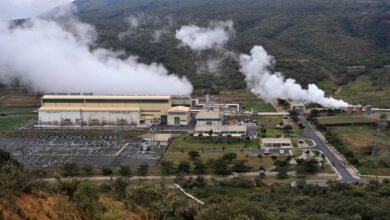
The Kenyan government is now banking on the electricity generating company, KenGen, to effect the remaining 15 percent power cut.
This follows KenGen’s move to connect its Olkaria I unit VI to the national grid, which is poised to increase the company’s output geothermal in the country.
“Last week marked the successful commissioning of the 83 megawatt (MW) plant which is now connecting power to the grid,” said KenGen boss Rebecca Miano.
The new plant brings KenGen’s total installed geothermal capacity to above 900 MW.
Kenya has remained committed to sourcing all its electricity generation from renewable sources, and KenGen recently began drilling additional geothermal wells at its Eburru Geothermal well located in Naivasha.
The connection of Olkaria I, VI coincides with a new record peak demand for electricity in the country which touched a high 2051 MW last month.
Construction of the new plant began in 2018, forming part of Kenya’s effort to go green and spar economic growth.
Linking of the new plant comes at a time the government is preparing the ground for another 15 percent cut in the cost of electricity.
For the second phase, the government has intimated that it will target lower income households.
The further cut has, however, been delayed with the Energy Cabinet Secretary Monica Juma saying the government remains committed to the plan.
“The reduction is predicated on the context that the commitment of the government to reduce tariffs still stands. In fact, if you look at the structure of tariffs there were categories which received a tariff reduction of more than 15 percent,” said CS Juma.
“We are working at it and are looking at disintegrating the various categories so that we can still push it, particularly to the most affected strata of society. It is not an agenda that has been dropped from the government perspective, we still are working on it.”
The follow-up tariffs cut from the initial trim in January are pegged on the outcome of ongoing negotiations between the government and Independent Power Producers (IPPs).
The new plant by KenGen increases Kenya’s installed geothermal power to 900MW from 713 MW, pushing up the share of KenGen’s geothermal installed capacity to 42 percent.
The government is banking on increased power supply from KenGen whose charges are lower than those of IPPs.
Kenya Power bought 46 percent or Ksh.41.1 billion of its electricity from State-controlled KenGen, with other top producers being Lake Turkana Wind and US-based geothermal firm, OrPower 4 Inc.
A kilowatt-hour (kWh) of geothermal goes for an average of Ksh.6.7 while a similar unit of thermal power costs Ksh.30.8 on average, highlighting the anticipated impact of an increased share of geothermal electricity to the national grid.
Kenya Power is banking on an increased share of geothermal power to help provide cheaper electricity to homes and households.





